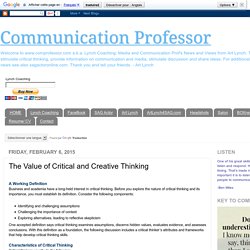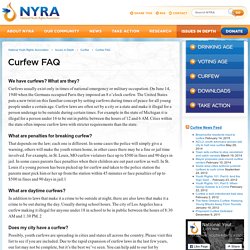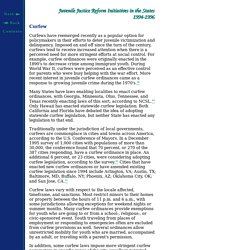

Communication Professor: The Value of Critical and Creative Thinking. One accepted definition says critical thinking examines assumptions, discerns hidden values, evaluates evidence, and assesses conclusions.

With this definition as a foundation, the following discussion includes a critical thinker’s attributes and frameworks that help develop critical thinking skills. Characteristics of Critical Thinking Critical thinkers usually do the following: Ask pertinent questions. Define criteria for analyzing ideas. POLL: Should Albuquerque bring back a teen curfew? ALBUQUERQUE, N.M.

—At least one city leader says it's time to put a teen curfew back on the books after three violent shootings in the last month. In those deadly shootings, teens were either the victims or suspects. A Status Report on Youth Curfews in America's Cities: A 347-City Survey. Many cities have imposed youth curfews in recent years.

A 1995 survey by The U.S. Conference of Mayors found that 272 cities, 70 percent of those surveyed, had a nighttime curfew. Fifty-seven percent of these cities considered their curfew effective. Since that survey was done the trend toward establishing curfews—both nighttime and daytime—has continued and more is known about their impact. This report updates the 1995 survey and provides additional information on the effectiveness of those curfews. Curfews don't keep kids out of trouble. Youth curfews are popular.

In poll after poll, Americans support laws that restrict teenagers' activities during certain hours of the day and night. Youth curfews are also logical. If youngsters are getting into trouble, it makes sense to get them off the streets. There's only one problem with youth curfews: They don't work. Reasons for Teen Curfews. Institute for Writing and Rhetoric. What is an Argument?

We've talked in depth about what constitutes an argument in What is an Academic Paper? Still, it's worth repeating the fundamental elements of argument here. OP-ED: Why Don’t Youth Curfews Work? Forget constitutional rights or fairness; doesn’t it seem logical that a curfew requiring police to remove an entire group of people from public spaces for hours would at least reduce public crimes and safety risks involving that group?

Well, it doesn’t. Research consistently “fails to support the argument that curfews reduce crime or criminal victimization,” a 2003 review of multiple studies found. Monrovia, California’s widely acclaimed youth curfew famously celebrated by then-President Bill Clinton was indeed followed by a decline in crime — one that was much larger during non-curfew hours than during curfew hours.
Vernon, Connecticut’s youth curfew was followed by increases in crime, particularly youthful offending, while nearby cities without curfews enjoyed decreases. National Youth Rights Association » Curfew FAQ. We have curfews?

What are they? Curfews usually exist only in times of national emergency or military occupation. On June 14, 1940 when the Germans occupied Paris they imposed an 8 o’clock curfew. Curfew. Curfew Curfews have reemerged recently as a popular option for policymakers in their efforts to deter juvenile victimization and delinquency.

Imposed on and off since the turn of the century, curfews tend to receive increased attention when there is a perceived need for more stringent efforts at social control. For example, curfew ordinances were originally enacted in the 1890's to decrease crime among immigrant youth. National Youth Rights Association » Curfew FAQ. Curfews don't keep kids out of trouble. Oakland, Berkeley, Bay Area & California. In the aftermath of the tragic daytime shooting of three-year-old Carlos Nava this summer, Oakland Councilmen Larry Reid and Ignacio De La Fuente renewed their call for a youth curfew in the city.

Even though the suspects in Nava's killing are adults, the councilmen contend that Oakland police need as many law enforcement tools as possible to cope with this year's spike in violent crime. Their proposal, which would make it illegal for youth under the age of eighteen to be out past 10 p.m. without a parent or guardian, also has been endorsed recently by the Oakland Tribune editorial board, and has been pushed by Tribune columnist Tammerlin Drummond and San Francisco Chronicle columnist Chip Johnson. However, a closer look at youth curfews reveals that there's little evidence that they lower juvenile crime rates in other cities, and instead can waste precious police resources.
In an interview, De La Fuente said he doesn't view curfews as a panacea. A Status Report on Youth Curfews in America's Cities: A 347-City Survey. Affirming the Consequent. Taxonomy: Logical Fallacy > Formal Fallacy > Propositional Fallacy > Affirming the Consequent Sibling Fallacy: Denying the Antecedent Alias:

Fallacies. A fallacy is a kind of error in reasoning. The list of fallacies contains 209 names of the most common fallacies, and it provides brief explanations and examples of each of them. Fallacies should not be persuasive, but they often are. Fallacies may be created unintentionally, or they may be created intentionally in order to deceive other people. Children in Adult Prison. Print E-Mail Share Across the United States, thousands of children have been sentenced as adults and sent to adult prisons.
Stats - Does Treating Kids Like Adults Make A Difference? Two assumptions are behind recent legislation passed in many U.S. states which make it easier to try juvenile offenders as adults. Young offenders will receive sentences in the adult criminal system which are harsher and more proportional to their crimes. The threat of this harsher punishment will result in lowered juvenile crime rates. Although there has not been extensive research into the deterrent effects of the stricter laws, the evidence that does exist indicates that deterrent effects are minimal or nonexistent, and that, in fact, trying juveniles in criminal court may actually result in higher rates of reoffending.
The Trouble With Trying Children as Adults. There are numerous issues surrounding trying juveniles as adults – particularly in cases where the possibility of life without parole exists. The ideas that shaped juvenile justice for over a hundred years have been degraded and attacked, particularly in state government, with a view that juveniles deserve harsher punishment. These ideas fit the overarching “tough on crime” view of many politicians (and often their constituents).